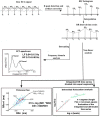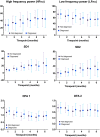Early transient dysautonomia predicts the risk of infantile epileptic spasm syndrome onset: A prospective cohort study
- PMID: 36619920
- PMCID: PMC9815183
- DOI: 10.3389/fneur.2022.1090155
Early transient dysautonomia predicts the risk of infantile epileptic spasm syndrome onset: A prospective cohort study
Abstract
Background: Infantile epileptic spasm syndrome (IESS) is an age-dependent epileptic encephalopathy with a significant risk of developmental regression. This study investigates the association between heart rate variability (HRV) in infants at risk of IESS and the clinical onset of IESS.
Methods: Sixty neonates at risk of IESS were prospectively followed from birth to 12 months with simultaneous electroencephalogram (EEG) and electrocardiogram recordings for 60 min at every 2-month interval. HRV metrics were calculated from 5 min time-epoch during sleep including frequency domain measures, Poincare analysis including cardiac vagal index (CVI) and cardiac sympathetic index (CSI), and detrended fluctuation analysis (DFA α1, DFA α2). To assess the effect of each HRV metric at the 2-month baseline on the time until the first occurrence of either hypsarrhythmia on EEG and/or clinical spasm, univariate cox-proportional hazard models were fitted for each HRV metric.
Results: Infantile epileptic spasm syndrome was diagnosed in 20/60 (33%) of the cohort in a 12-month follow-up and 3 (5%) were lost to follow-up. The median age of developing hypsarrhythmia was 25 (7-53) weeks and clinical spasms at 24 (8-40) weeks. Three (5%) patients had clinical spasms without hypsarrhythmia, and 5 (8%) patients had hypsarrhythmia before clinical spasms at the initial presentation. The infants with high CSI (hazard ratio 2.5, 95% CI 1.2-5.2, P = 0.01) and high DFA α1 (hazard ratio 16, 95% CI 1.1-240, P = 0.04) at 2 months were more likely to develop hypsarrhythmia by the first year of age. There was a trend toward decreasing CSI and DFA α1 and increasing CVI in the first 8 months of age.
Conclusion: Our data suggest that relative sympathetic predominance at an early age of 2 months may be a potential predictor for developing IESS. Hence, early HRV patterns may provide valuable prognostic information in children at risk of IESS allowing early detection and optimization of cognitive outcomes. Whether early intervention to restore sympathovagal balance per se would provide clinical benefit must be addressed by future studies.
Keywords: autonomic dysfunction; heart rate variability; hypsarrhythmia; infantile spasm (IS); perinatal brain injury.
Copyright © 2022 Goswami, Maguire, Chau, Tam, Pinchefsky, Whitney, Wilson, Miller and Cortez.
Conflict of interest statement
The authors declare that the research was conducted in the absence of any commercial or financial relationships that could be construed as a potential conflict of interest.
Figures



Similar articles
-
Nutritional vitamin B12 deficiency-associated Infantile epileptic spasms syndrome: Clinico-neurophysiological presentation, response to treatment, and neurodevelopmental outcome.Seizure. 2023 Aug;110:93-98. doi: 10.1016/j.seizure.2023.06.003. Epub 2023 Jun 5. Seizure. 2023. PMID: 37331199
-
Treatment efficacy for infantile epileptic spasms syndrome in children with trisomy 21.Front Pediatr. 2025 Feb 12;13:1498425. doi: 10.3389/fped.2025.1498425. eCollection 2025. Front Pediatr. 2025. PMID: 40013114 Free PMC article.
-
Factors Influencing the Response of Patients with Infantile Epileptic Spasms Syndrome to ACTH as Repeated First-Line Therapy.Neurol Ther. 2025 Jun;14(3):759-774. doi: 10.1007/s40120-025-00722-0. Epub 2025 Mar 10. Neurol Ther. 2025. PMID: 40063195 Free PMC article.
-
Genetic Advancements in Infantile Epileptic Spasms Syndrome and Opportunities for Precision Medicine.Genes (Basel). 2024 Feb 21;15(3):266. doi: 10.3390/genes15030266. Genes (Basel). 2024. PMID: 38540325 Free PMC article. Review.
-
Mechanisms of infantile epileptic spasms syndrome: What have we learned from animal models?Epilepsia. 2024 Feb;65(2):266-280. doi: 10.1111/epi.17841. Epub 2023 Dec 18. Epilepsia. 2024. PMID: 38036453 Review.
References
-
- Baumgartner C, Lurger S, Leutmezer F. Autonomic symptoms during epileptic seizures. Epileptic Disord. (2001) 3:103–16. - PubMed
LinkOut - more resources
Full Text Sources

